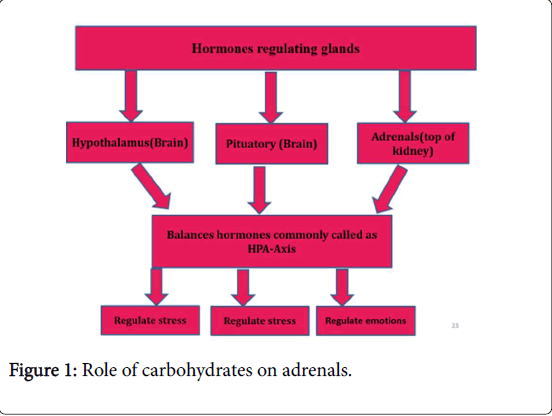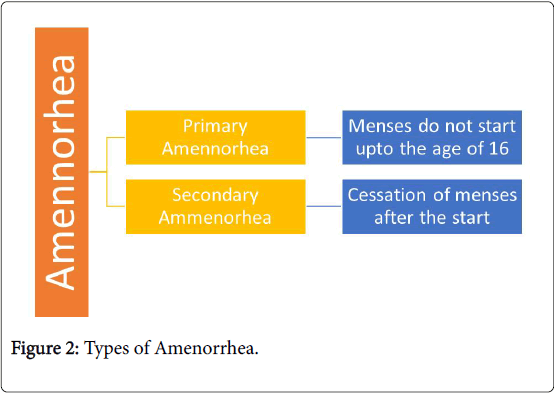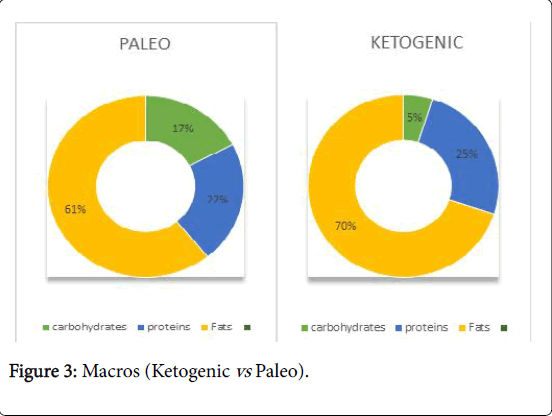Review on Role of Ketogenic Diet and Excessive Workout on Hormonal Imbalances in Women
Received: 11-Jul-2018 / Accepted Date: 10-Sep-2018 / Published Date: 14-Sep-2018 DOI: 10.4172/2165-7904.1000373
Keywords: Ketones; Hormones; Cortisol; Health; Weight loss
Introduction
Ketogenic diet (KD) is also known as LCHF (Low carb high fat) diet. This diet involves carbohydrate intake typically less than 20 g per day, high amount of fat and moderate amount of protein the main aim is to low down the blood glucose level along with insulin level. After the state is achieved body use fats as a source of energy instead of carbohydrates and body becomes the fat burning machine. It is also important to limit protein because in many studies it has been proved that excess protein converts to glucose and can raise the blood sugar level [1-10].
A person is said to be in ketosis when the fasting blood glucose is between 60-80 mg/dl. The difference between ketogenic diet and other low carb diet is a low carb diet may contain much protein.
When a person is “in ketosis”, fasting morning blood glucose levels tend to average between 60 mg/dl and 85 mg/dl and blood ketone levels rise to at least 0.5 mM (with much higher levels recommended for certain conditions). These parameters distinguish ketogenic diets from other low-carbohydrate diets, which may contain much amount of protein and/or carbohydrate to produce these metabolic effects (Figure 1).
The state of excessive calorie deficit, stress levels and excessive workout out specially exercises including cardiovascular system (running, cross-fit, skipping) stimulates the glands.
In long term excessive stress, exercise and poor carbs deficit diet can put high amount of pressure on glands and there will be high production of stress hormone called cortisol. And ultimately the HPA axis will disturbed [11-15].
History
The ketogenic diet was accepted as a remedy for epilepsy in the 1920s and 30s. The purpose of fasting in the treatment of this disease has been acknowledged to the humankind for thousands of years and was analyzed in detail by ancient Greek and Indian physicians [16-19]. An early discourse in the Hippocratic Corpus, “On the Sacred Disease,” explains how modifications in diet served a role in epilepsy management. He also explains in “Epidemics”, how a man was treated from epilepsy when he refrained completely from ingesting food or drink [20-25].
The primary modern scientific study into fasting as a treatment of epilepsy was accompanied in France, in 1911. Formerly, potassium bromide was used to cure epileptics, but these compound reduced patients’ mental abilities. Instead, twenty epilepsy patients obeyed a low-calorie, vegetarian food plan that was merged with fasting [26]. Two patients showed substantial improvements, although most could not stick to the dietary limitations. However, the diet was found to recover the patient’s mental abilities compared with the outcomes of taking potassium bromide [27].
During the initial 20th century, an American named Bernarr McFadden propagated the aim of fasting as a means of reinstating health. His student osteopath, Hugh Conklin, initiated fasting as a treatment method for monitoring epilepsy. Coklin anticipated that epileptic seizures were triggered by a toxin secreted in the intestine and recommended that fasting for 18 to 25 days could cause the toxin to disintegrate. His epileptic patients were put on a “water diet,” which he stated alleviated 90% of children and 50% of adults. Inspection of the study that was accomplished later showed that, 20% of Coklin’s patients became seizure-free, while 50% confirmed some improvement. The fasting therapy was soon accepted as a part of widely held therapy for epilepsy and in 1916; Dr McMurray informed to the New York Medical Journal that he had magnificently treated epileptic patients by prescribing a fast, followed by a diet free of starch and sugar [27].
It was in 1921 that an endocrinologist Rollin Woodyatt observed that three water-soluble compounds, acetone, β-hydroxybutyrate and acetoacetate (together called ketone bodies) were produced by the liver as a product of starvation or if they obeyed a diet rich in fat and low in carbohydrates. Russel Wilder from the Mayo Clinic termed it the “ketogenic diet” and used it as a treatment for epilepsy.
Later research in the 1960s showed that more ketones are produced by medium-chain triglycerides (MCTs) per unit of energy because they are transferred quickly to the liver via the hepatic portal vein, as opposed to the lymphatic system. In 1971, Peter Huttenlocher formulated a ketogenic diet where 60% of the calories came from MCT oil, which permitted more protein and carbohydrates to be involved in relation to the original ketogenic diet, so that parents could cook more delicious meals for their children with epilepsy. Many hospitals also approved the MCT diet in place of the original ketogenic diet, although some used a combination of the two [27].
Low Carb, Stress and Amenorrhea
Amenorrhea is a condition when women’s menstrual flow/Aunt flow is supressed for more than 90 days or so. The Amenorrhea is classified broadly into two categories.
The reasons contributing primary are Turner syndrome, Mullerian syndrome vaginal atresia Cryptomenorrhea, Imperforate hymen and Secondary involves Pregnancy-menopause, breastfeeding, polycystic ovaries (pcod/pcos), drug induction (Figure 2).
However, the most common secondary amenorrhea is hypothalamic amenorrhea which is related to exercise, stress and eating disorders such as bulimia. Studies suggest that low carb diets, too much stress enhance the stress hormone called “Cortisol”.
Amenorrhea is mostly observed in athletes, marathon runners and women’s performing exerted exercise involving low body weight. The low body weight, few carbs/calories and excessive exercise switch on body’s starvation mode. When the calorie intake and the carb intake is less than the required for maintenance of different body system problem is created.
The major problem is the estrogen deficit state which can cause infertility, vaginal atrophy and can increase the chances of osteoporosis.
Clinical Studies
In a retrospective study performed from 1994-2002 on 45 children, aged 12-19 years. The children enrolled were patients and were put on ketogenic diet [28].
In order to represent a starvation state efficiently, each patient must be as close to his or her standard body weight so that we can strategize weight loss in our patients [28].
Twenty-seven (60%) of the adolescents stated a decline in their weight during the intake of the ketogenic diet out of which seven revealed an unintentional weight loss of ≥ 25% of their preliminary body weight. At the same time, 18 patients were cured with VPA (with which weight gain is an identified side effect) while 13 (72%) were capable to lose weight. Four adolescents remarked a decrease in energy related with the weight loss, all of whom were below their ideal body weight at diet commencement.
Nine (45%) girls informed menstrual issues during the consumption of the ketogenic diet precisely, amenorrhea (six) and delayed puberty (three). Only four of nine girls with menstrual abnormalities had weight loss. One adolescent started hormonal therapy (combination oestrogen/progesterone oral contraceptive) to stimulate menses; eight experienced a return of normal menses after diet termination. One girl reported menorrhagia after diet withdrawal; this was subsequently cured with an oral contraceptive. Two individuals stated a rise in seizure activity; two, thinning hair and/or hair loss, both of which were altered with vitamin supplementation; two, increased bruising or bleeding; and two, prejudiced reports of restricted growth [28].
Limitations and Recommendations
The gap of knowledge however still exists despite of these many research and conclusions obtained. The mechanism of working of different low carbohydrate diets in the body is still not notable. Currently, many health centers of ketogenic diet and ketogenic kitchens around the world are in popular demand. However, most nutritionist, healthcare physicians and dietitians have no accurate certification or training in the ketogenic diet. Therefore, it leads to incorrect macros calculation. It is our hope and belief that when physicians and health care professionals are sufficiently trained there will be no such problems. These questions are not answered till date, while continuous efforts are made to solve the tangled mystery of the diet. It can be foreseen that research and it’s finding will make the good utility of the same more frequent.
Birth control pills and Paleo diet
Of course, taking pills is the solution to turn back the hormonal system. Hormonal pills can help amenorrhea. These pills contain combination of estrogen and progesterone in low doses. These pills come in 21-day or 28-day tablet pack. However, some are taken for 5 days twice a day. And after the last dose within a week withdrawal bleed can be experienced.
But for long run for weight management along with health Paleo can be adopted.
Paleo diet is about eliminating the grains, legumes and dairy. The former two is due to the presence of phytic acid and the latter is because of lactose which is hard to digest. Paleo is a long term diet which can be followed. The differences can be collated in Table 1.
| Food Category | Keto | Paleo |
|---|---|---|
| Grains | Not allowed | Not allowed |
| Fruits | Only 5% | Allowed |
| Dairy | Not allowed | Not allowed |
| Non-starchy vegetable | Allowed | Allowed |
| Legumes (peanuts) and beans | Not allowed (peanuts-controversial) | Not allowed |
| Nuts (walnut/almonds) | Allowed | Allowed |
| Fats and oils (healthy) | Allowed | Moderate |
Table 1: Ketogenic vs Paleo categories of food.
Nutrients and macros
Calorie counting is now associated with a new diet fever called” IIFM”. IIFM stands for ‘If it fits my macros’. This diet targets to analyze and monitor calorie deficit state together with the account of calories coming from macronutrients/macros-Typically from carbohydrates, proteins and fats. In short, how much you are eating and what you are eating can drastically enhance the weight loss, muscle building parameters and maintain hormonal balance.
The various applications help to stay on track as shown in Figure 3.
Macros manipulation is a booster for getting the hormones back on track and also requires to convince your body that it’s not in danger. This includes proper sleep, cutting of extensive cardiovascular exercises and probably eating carbohydrates in sufficient amount.
Limitations and Recommendations
The gap of knowledge however still exists despite of these many research and conclusions obtained. The mechanism of working of different low carbohydrate diets in the body is still not notable. Currently, many health centres of ketogenic diet and ketogenic kitchens around the world are in popular demand. However, most nutritionist, healthcare physicians and dietitians have no accurate certification or training in the ketogenic diet. Therefore, it leads to incorrect macros calculation. It is our hope and belief that when physicians and health care professionals are sufficiently trained there will be no such problems.These questions are not answered till date, while continuous efforts are made to solve the tangled mystery of the diet . It can be foreseen that research and it’s finding will make the good utility of the same more frequent.
Conclusion
At sometimes, it is difficult to restrict yourself during social gatherings and daily busy lifestyles. Therefore, ketogenic diet being more dramatic and causes more harm to women’s hormonal system so is difficult to follow in long run. However, Paleo can produce gradual weight loss, benefits the gut, digestive system as well as do not cause any harm to hormonal system in women. So, Paleo is more likely to be beneficial.
References
- Samaha FF, Iqbal N, Seshadri P, Chicano KL, Daily DA, et al. (2003) A low-carbohydrate as compared with a low-fat diet in severe obesity. N Engl J Med 21: 2074-2081.
- Yancy WS Jr, Olsen MK, Guyton JR, Bakst RP, Westman EC (2004) A low-carbohydrate, ketogenic diet versus a low-fat diet to treat obesity and hyperlipidemiaA randomized, controlled trial. Ann Intern Med 10: 769-777.
- Volek JS, Westman EC (2002) Very-low-carbohydrate weight-loss diets revisited. Cleveland Clin J Med 69: 849-849.
- Wycherley TP, Brinkworth GD, Keogh JB, Noakes M, Buckley JD, et al. (2010) Longâ€term effects of weight loss with a very low carbohydrate and low fat diet on vascular function in overweight and obese patients. J Intern Med 267: 452-461.
- Brinkworth GD, Noakes M, Buckley JD, Keogh JB, Clifton PM (2009) Long-term effects of a very-low-carbohydrate weight loss diet compared with an isocaloric low-fat diet after 12 mo. Am J Clin Nutr 90: 23-32.
- LaGory EL, Giaccia AJ (2013) A low-carb diet kills tumor cells with a mutant p53 tumor suppressor gene: The Atkins diet suppresses tumor growth. Cell Cycle 12: 718-719.
- Klement RJ, Kammerer U (2011) Is there a role for carbohydrate restriction in the treatment and prevention of cancer. Nutr Metab (Lond) 8: 1-16.
- Fine EJ, Segal-Isaacson CJ, Feinman RD, Herszkopf S, Romano MC, et al. (2012) Targeting insulin inhibition as a metabolic therapy in advanced cancer: A pilot safety and feasibility dietary trial in 10 patients. Nutri 28: 1028-1035.
- Paoli A, Grimaldi K, Toniolo L, Canato M, Bianco A, et al. (2012) Nutrition and acne: Therapeutic potential of ketogenic diets. Skin Pharmacol Physiol 25: 111-117.
- Paoli A, Rubini A, Volek JS, Grimaldi KA (2013) Beyond weight loss: A review of the therapeutic uses of very-low-carbohydrate (ketogenic) diets. Eur J Clin Nutr 67: 789-796.
- Westman EC, Yancy WS, Edman JS, Tomlin KF, Perkins CE (2002) Effect of 6-month adherence to a very low carbohydrate diet program. Am J Med 113: 30-36.
- Freeman JM, Kossoff EH, Hartman AL (20047) The ketogenic diet: one decade later. Pediatrics 119: 535-543.
- Noto H, Goto A, Tsujimoto T, Noda M (2013) Low-Carbohydrate diets and all-cause mortality: A systematic review and meta-analysis of observational studies. PloS one 8: e55030
- Paoli A, Grimaldi K, D’Agostino D, Cenci l, Moro T, et al. Ketogenic diet does not affect strength performance in elite artistic gymnasts. J Intern Society Sports Nutri 9: 34.
- Mady MA, Kossoff EH, McGregor AL, Wheless JW, Pyzik PL, et al. (2003) The ketogenic diet: Adolescents can do it, too. Epilepsia 44: 847-851.
- Bertoli S, Trentani C, Ferraris C, De Giorgis V, Veggiotti P, et al. (2014) Long-term effects of a ketogenic diet on body composition and bone mineralization in GLUT-1 deficiency syndrome: A case series. Nutrition 30: 726-728.
- Chapman J (2013) Specialty practice series: Hair loss: Getting to the root of the problem. AJP 94: 70-74.
- Brinkworth GD, Buckley JD, Noakes M, Clifton PM, Wilson CJ (2009) Long-term effects of a very low-carbohydrate diet and a low-fat diet on mood and cognitive function. Arch Intern Med 169: 1873-1880.
- Shelly Fan (2016) The fat-fueled brain: unnatural or advantageous? Sci Am (2013) – Retrieved 2013: 1-20.
- Rho JM, Rogawski MA (2007) The ketogenic diet: Stoking the powerhouse of the cell.†Epilepsy Curr 7: 58-60.
- Noh HS, Lee HP, Kim DW, Kang SS, Cho GJ, et al. (2004) A cDNA microarray analysis of gene expression profiles in rat hippocampus following a ketogenic diet. Brain Res Mol Brain Res 129: 80-87.
- Astrup A, Meinert Larsen T, Harper A (2004) Atkins and other low carbohydrate diets: Hoax or an effective tool for weight loss? Lancet 364: 897-899.
- Erlanson-Albertsson C, Mei J (2005) The effect of low carbohydrate on energy metabolism. Int J Obes (Lond) 29: S26-S30.
- Boden G, Sargrad K, Homko C, Mozzoli M, Stein TP (2005) Effect of a low-carbohydrate diet on appetite, blood glucose levels, and insulin resistance in obese patients with type 2 diabetes. Ann Intern Med 142: 403-411.
- Sumithran P, Prendergast LA, Delbridge E, Purcell K, Shulkes A, et al. (2013) Ketosis and appetite-mediating nutrients and hormones after weight loss Eur J Clin Nutr 67: 759-764.
- Rolls J (2000) The role of energy density in the overconsumption of fat. J Nutr 130: 268S-271S.
- Mady MA, Kossoff EH, McGregor AL, Wheless JW, Pyzik PL, et al. (2003) The ketogenic diet: Adolescents can do it, too. Epilepsia 44: 847-851.
Citation: Verma P and Trikha D (2018) Review on Role of Ketogenic Diet and Excessive Workout on Hormonal Imbalances in Women. J Obes Weight Loss Ther 8: 373. DOI: 10.4172/2165-7904.1000373
Copyright: © 2018 Verma P, et al. This is an open-access article distributed under the terms of the Creative Commons Attribution License, which permits unrestricted use, distribution, and reproduction in any medium, provided the original author and source are credited.
Share This Article
Recommended Journals
Open Access Journals
Article Tools
Article Usage
- Total views: 9093
- [From(publication date): 0-2018 - Apr 21, 2025]
- Breakdown by view type
- HTML page views: 8157
- PDF downloads: 936



